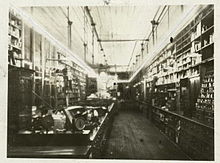利用者:加藤勝憲/ダニエル・マクファーラン・ムーア
ダニエル・マクファーラン・ムーア Daniel McFarlan Moore | |
|---|---|
 1906年にムーア灯の照明下で撮影。 | |
| 生誕 |
1869年2月27日 ペンシルヴェニア州ノーサンバーランド |
| 死没 |
1936年6月15日(67歳没) ニュージャージー州イーストオレンジ |
| 死因 | 殺人 |
| 職業 | 電気技術者 |
| 配偶者 | メアリー・アリス・エリオット(1895年に結婚) |
| 親 |
アレクサンダー・デイヴィス・ムーア マリア・ルイーザ・ダグラス・ムーア |
ダニエル・マクファーラン・ムーア(Daniel McFarlan Moore、1869年2月27日 – 1936年6月15日)は米国の電気技術者、発明家。「ムーアランプ」と呼ばれる新しい光源を発明し、1900年代に製造・販売事業を興した。
ムーアランプは、白熱灯の代わりにガス放電を利用した光源として商業的に初めて実用化された、現在のネオン管や蛍光灯の前身となるものである[1]。
後に、ムーアは、電子表示システム用に小型のネオン管を開発した。
生い立ち
[編集]1869年、ペンシルヴェニア州ノーサンバーランドで、牧師である父アレクサンダー・デイヴィス・ムーアと母マリア・ルイーザ・ダグラス・ムーアの息子として生まれた。
1889年、リーハイ大学を卒業[2][3]。1895年、メアリー・アリス・エリオットと結婚し3人の子供ができた。
経歴
[編集]1890年、エジソン・マニュファクチャリング・カンパニーの技術部に入社した[2]。ムーアは、ある時期から、ハインリッヒ・ガイスラーが1850年代に初めて開発したグロー放電による光の生成の実験を始めた。
ムーアが白熱電球に代わるものとして、発光する気体のチューブをいじり始めたことを知り、「私の光はどうしたんだい?」とトーマス・エジソンは、そう尋ねたと言われている。ムーアは、「小さすぎるし、熱すぎるし、赤すぎる」と屈託なく答えたと言われている[4]。
ムーアは1894年に退社し、自身の会社であるムーア電気会社とムーア照明会社を設立した[5]。
ムーアランプ
[編集]
ムーアは1896年までにグロー放電照明装置を考案していた[1]。ムーアランプは、よく知られたガイスラー管を拡張したもので、空気を抜いて別のガスを挿入したガラス管を使用していた。電流を流すと低圧ガスが光る。ムーアランプは窒素や二酸化炭素を発光ガスとして利用していたが、ムーアの技術革新は、ランプ内のガスが電極やガラスに徐々に失われていくのを補うものであった。二酸化炭素は良質な白色光をもたらした。最初の商業的な設置は1904年にニュージャージー州ニューアークの金物店で行われた[5]。このランプは1ワットあたり約10ルーメンをもたらし、炭素フィラメントをベースとした白熱灯の約3倍の出力であった[4]。アーサー・ブライトは、「真空管は設置するのに高価で、複雑で、非常に高い電圧を必要としたにもかかわらず、その動作上の利点は、店舗、オフィス、同様の一般照明用途、写真撮影、一部の広告や装飾用途で制限された使用を見つけるのに十分なほど大きかった」と書いている[7][5]。
Moore had devised his glow discharge lighting system by 1896.[1] ムーアランプ was an extension of the well-known Geissler tube, which used glass tubes from which the air had been removed and a different gas inserted. The low-pressure gas glows when a current is passed through it. As described in 1915, "In the Moore system of lighting the essential feature is the introduction of a special valve which automatically admits gas into the tube as the supply becomes exhausted."[6] ムーアランプ utilized nitrogen or carbon dioxide as the luminous gas; Moore's innovation compensated for the gradual loss of gas in the lamp to the electrodes and the glass. Carbon dioxide gave a good quality white light. The first commercial installation was done in 1904 in a hardware store in Newark, New Jersey.[5] The lamp yielded about 10 lumens per watt, which was about triple the output of incandescent lights based on carbon filaments.[4] Arthur Bright has written, "Despite the fact that the tube was expensive to install, complicated, and required very high voltages, its operating advantages were great enough for it to find restricted use in stores, offices, and similar general lighting uses as well as in photography and some advertising and decorative applications."[5]
ムーア管のささやかな成功は、標準的な白熱電球用のより良いフィラメントを開発する原動力のひとつとなった。タングステンフィラメント電球は、カーボンフィラメントよりも十分に改善されていたため、ムーア管は「徐々に市場から姿を消し、昼光色であることから優れていたカラーマッチング用の短い炭酸ガス管だけが使用されるようになった」。ゼネラル・エレクトリック社は、1912年にムーア社の2つの会社とムーア氏の特許を吸収した。ムーア自身はゼネラル・エレクトリック社の研究所に復帰した」[5]。
The modest success of the Moore tubes was among the drivers for developing better filaments for standard incandescent light bulbs. Tungsten filament bulbs were a sufficient improvement over carbon filaments that the Moore tubes "gradually disappeared from the market, leaving only short carbon-dioxide tubes in use for color matching, in which they excelled because of their daylight color. The General Electric Company absorbed the two Moore companies and Moore's patents in 1912. Moore himself rejoined General Electric's laboratory force."[5]
Miniature neon lamp
[編集]
ムーアがゼネラル・エレクトリック社で発明した小型ネオンランプは、20世紀を通じて電子ディスプレイに使われ続け、プラズマ・ディスプレイの先駆けとなった。このランプとムーアのさらなる発明は、テレビの初期の発展にも重要な役割を果たした。特に1917年頃、ムーアは「ネガ・グロー」ネオンランプを開発した[8]。これは、ネオン照明に使用されるはるかに大きなネオン管とはまったく異なる設計の小型ランプであった。スミソニアン協会のウェブサイトには、「これらの小型で低電力の装置は、『コロナ放電』と呼ばれる物理原理を使用している」と記されている。ムーアは電球の中に2つの電極を近接して取り付け、ネオンやアルゴンガスを加えた。電極はガスによって赤や青に明るく光り、ランプは何年も持続した。電極はほとんどどんな形にもできたので、よく使われたのは空想的な装飾ランプだった。グローランプは、1970年代に発光ダイオード(LED)が受け入れられるまで、計器盤のインジケーターや多くの家電製品で実用化されていた」[4]。1924年には、当時「テレフォトグラフィー」(電気や無線で静止画を送ること)と呼ばれていたものに使用される真空電球を発明し、1925年にはテレビで使用するために発明を改良した[3][9]。
Moore's inventions at General Electric included a miniature neon lamp that remained a fixture in electronic displays throughout the twentieth century, and was a forerunner of plasma displays. Both the lamp and his further inventions were also important to the early development of television. In particular, around 1917 Moore developed a "negative glow" neon lamp. These were miniature lamps with a very different design than the much larger neon tubes used for neon lighting; a Smithsonian Institution website notes, "These small, low power devices use a physical principle called 'coronal discharge.' Moore mounted two electrodes close together in a bulb and added neon or argon gas. The electrodes would glow brightly in red or blue, depending on the gas, and the lamps lasted for years. Since the electrodes could take almost any shape imaginable, a popular application has been fanciful decorative lamps. Glow lamps found practical use as indicators in instrument panels and in many home appliances until the acceptance of light-emitting diodes (LEDs) in the 1970s."[4] In 1924 he invented the vacuum bulbs used in what was at that time called "telephotography" (sending still pictures by electricity or radio), and in 1925 improved the invention for use in television.[3][7]
Moore was awarded the John Scott Medal of the Franklin Institute in 1911.[8]
死去
[編集]1936年6月15日、67歳の時、ムーアはニュージャージー州イーストオレンジの自宅の芝生の上で、自分が申請した発明がすでにムーアに付与された特許の対象であったことに激怒した失業中の発明家によって射殺された[9][10]。
発明特許
[編集]- アメリカ合衆国特許第 496,366号 Electrical Light Display (1893)
- アメリカ合衆国特許第 613,864号 Phosphorescent Electrical Lighting (1898)
- アメリカ合衆国特許第 1,014,247号 Fire for Joints in Vacuum Tubes (1912)
- アメリカ合衆国特許第 1,316,967号 Gaseous-Conduction Lamp (1919)
脚注
[編集]- ^ a b “Mr. Moore's Etheric Light. The Young Newark Electrician's New And Successful Device.”. The New York Times. (October 2, 1896) 2008年5月26日閲覧。 Paid access.
- ^ a b The National Cyclopedia of American Biography: Volume 13. J. T. White Company. (1906). p. 548
- ^ a b “Practical Television”. Time. (January 23, 1928) 2008年5月26日閲覧。.
- ^ a b c “Lamp Inventors 1880-1940: Moore Lamp”. The Smithsonian Institution. Template:Cite webの呼び出しエラー:引数 accessdate は必須です。
- ^ a b c d Bright Jr., Arthur A. (1949). The Electric-Lamp Industry. MacMillan. pp. 221–223
- ^ Gaster, Leon; Dow, John Stewart (1915). Modern illuminants and illuminating engineering. Whittaker & Co.. pp. 107–111
- ^ Lankes, L. R. (1979). “Historical Sketch of Televisions Progress”. In Fielding, Raymond. A Technological History of Motion Pictures and Television: An Anthology from the Pages of the Journal of the Society of Motion Picture and Television Engineers. University of California Press. p. 233. ISBN 9780520039810
- ^ “Franklin Laureate Database”. 2010年11月20日閲覧。 “D. McFarlan Moore; Year: 1911; Subject: Engineering; Award: Scott - on behalf of City of Phila; Citation: Vacuum tube electric light”
- ^ “Inventor Is Slain Near Jersey Home”. The New York Times. (June 16, 1936) 2008年5月26日閲覧. "Footprint A Clue. D.M. Moore, Electrical Expert, Shot Down Outside Garage In East Orange At Dawn. Assailant Knew Of Plans Victim Arose Earlier Than Usual To Start Trip. Had No Enemies, Police Say. The distinguished career of Daniel McFarlan Moore, whose electrical researches and inventions brought the cooperation and applause of Thomas A. Edison, Sir William Ramsay and other eminent scientists, came to an abrupt and tragic end here early this morning at the hand of an unknown assassin."
- ^ “Moore Murder Key Is Seen By Police In Jersey Suicide.”. The New York Times. (June 17, 1936) 2008年5月26日閲覧. "An extraordinary series of coincidences attending the murder Monday morning in East Orange, N.J., of Daniel McFarlan Moore, eminent engineer, and the suicide yesterday of Jean Philip Gebhardt at New Monmouth, N.J., has caused the authorities to center the murder investigation on the suicide."
[[Category:1936年没]] [[Category:1869年生]] [[Category:ニュージャージー州イーストオレンジ出身の人物]] [[Category:ニューアーク出身の人物]] [[Category:ゼネラル・エレクトリックの人物]] [[Category:アメリカ合衆国の発明家]] [[Category:未査読の翻訳があるページ]]
